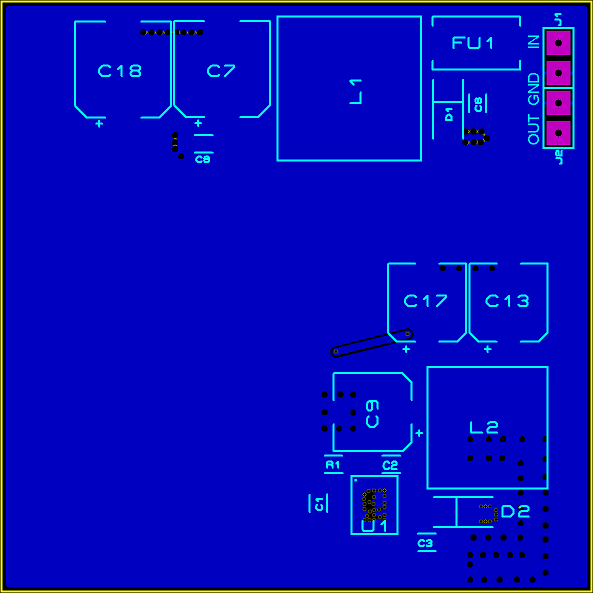I would use the adjustable output voltage version of the part rather than the 5v part. But even if the 5v version is used, you should include the feedback voltage divider (just use a zero ohm resistor for the high side, and don't install the low side resistor). This will give you more flexibility in the long run, just in case you need a different voltage.
In general, your traces are not wide enough. Most critical will be the trace from C9 to U1.7-8, anything connected to U1.6, L2 to C17/C13, and GND between U1 and everywhere. These are the nets that will have lots of switching currents and you want to make sure they are short and wide.
U1 could be dissipating some heat, and the connection you have to the GND pad on the bottom of the part isn't going to be enough. You should increase the size of the GND plane on the top side of the PCB. Do this by moving R1 & C1 so the GND plane can expand out from under the chip.
It's hard to tell, but I don't think that you have GND connected between the top and bottom half of the circuit. You really should just have one solid ground plane under the entire PCB and not try to do anything fancy to isolate the different sections. (Exception: you still want the GND plane to cool U1, just use vias to tie that plane to the overall GND plane.)
Conclusion: Thicker traces, better cooling, lots of GND.
Edit: Here's my comments for Rev B...
The bottom should be one complete GND plane. Not split into two halfs. This is critical and should not be ignored.
When possible, don't have GND traces on the top layer-- that's what the GND plane is for. This is especially true for the GND between J1, D1, and C17.
Also, the GND trace to C8 makes that cap completely useless. The trace inductance is going to be huge. Instead use a couple of vias to the GND plane directly at the cap. C8 should probably be located next to C9.
The traces linking the top and bottom half of the circuit are way too thin. Double or triple them. Or better yet, use a copper plane/shape/fill/whatever.
The single trace on the bottom side (from C17 to U1) should be rerouted so that it is mostly on the top of the PCB. This will help keep the GND plane on the bottom more intact and less likely to do bad things.
It's hard to tell from your pictures, but you might need more vias from the GND pad/plane on U1 to the GND plane on the bottom layer. Getting more of the heat to the bottom layer is good.
The GND plane on the top layer that is connected to D2 and goes under L2 needs more vias to the GND plane on the bottom of the PCB. Put at least 2 vias under L2, and maybe a third in the lower right corner.





